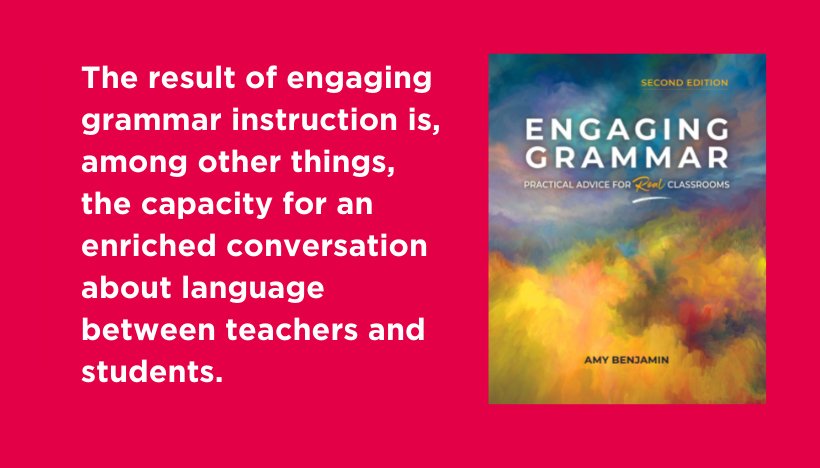This post was written by NCTE member Amy Benjamin.
In the second edition of my book Engaging Grammar: Practical Advice for Real Classrooms (NCTE, 2021), I describe all kinds of ways to make grammar instruction interesting, memorable, and perhaps most important, useful. I have found that grammar instruction that recruits the features of sound teaching, e.g., use of visuals, games, inductive reasoning, rhythm, socializing, open-endedness, age appropriateness, sense of fun, and open-mindedness—is well worth the effort. The result of engaging grammar instruction is, among other things, the capacity for an enriched conversation about language between teachers and students.
When teachers and students share a common language about grammar, the conversation about a written work-in-progress can include advice like this:
“You’re starting too many sentences with the simple subject, and that is giving your writing that short-and-choppy style. Try beginning some sentences with dependent clauses or prepositional phrases. Don’t forget the comma.”
“This verb needs to be in the past tense. Keep your verb tense consistent.”
“I’m not sure of the pronoun referent here.”
“Use more proper nouns. Then you will be specific.”
“Add some more prepositional phrases for visual detail.”
“We need an adverb, not an adjective in this sentence because you have an action verb.”
“To make your sentences come alive, use strong action verbs.”
“Try an inverted adjective pair. It will emphasize your adjectives and give the sentence a poetic style.”
“This is an irregular verb. It goes like this in the participial form. . . .”
Now, wouldn’t that be better than being at a loss for words to explain not only what is incorrect, but also what is grammatically correct but could be stylistically better?
Having worked with thousands of teachers at elementary, middle, and high school levels, I can attest to the fact that teachers feel at sea when it comes to teaching grammar. Many lack the knowledge itself, having never been taught the basics in any coherent way. Others rely on ineffective worksheets and memorized rules that don’t describe the changing and varied forms of English.
Some teachers, I regret to say, talk down to students when teaching grammar, showing disrespect for the style of English their students speak with friends and at home, whether they mean to alienate them or not. Some insist upon outdated, arbitrary rules that modern professional writers long ago eschewed. And (see what I did there?) everybody laments that the kind of grammar instruction they’ve been delivering is simply not retained. “We have to teach the same things over and over again, year after year,” they complain.
I challenge, and offer specific alternatives to, “skill-and-drill” grammar as well as the “caught, not taught” thinking that usually prevails in the workshop model. Whether we teach in a workshop model for reading and writing, or whether we set aside time dedicated to circling nouns and verbs (again), the refrain from teachers is the same: Students are not applying the rules of standardized English in their writing.
My approach, on the other hand, is not just old (expired) wine in a new bottle. I combine the principles of linguistics (morphology, syntax, pragmatics), contrastive analysis of formal and informal English, and rhetorical effects with the principles of the student-centered classroom. These include multi-modal learning, nonverbal processing, cooperative learning, and high level of student interest and engagement. It works.
I have simplified the explanation of grammatical terminology, using sentence frames (e.g., A noun is a word that makes sense after the word the; To locate the verb in a sentence, change the tense; the word that changed is the verb.) I use morphology charting to illustrate the flexible nature of nouns, verbs, adjectives, and adverbs in English. Teaching the parts of speech (and the idea that there are eight of them is inaccurate) is easier than you might think. So is teaching sentence functions, pronoun case, and punctuation.
If your students have insufficient information about grammar, they know it. If you feel less than competent teaching grammar, you know it, and you wouldn’t be alone if you avoided it altogether. But the Second Edition of Engaging Grammar will help you and your students take this message to heart: whenever you feel lost in the forest of grammar, remember that you already know it!
Why go to the trouble of teaching it, then?
Because teachers and students need the language-of-the-language to have productive conversations. Because knowing the grammatical system and terminology of one language helps you learn another. And because some people find grammar interesting, even fascinating. Even fun. So, I hope you’ll give Engaging Grammar, Second Edition, a chance to make something old, something new!
Amy Benjamin is a nationally recognized consultant who specializes in improving student performance through literacy instruction on the secondary level. She is the author of numerous books and is past president of the Assembly for the Teaching of English Grammar (ATEG), a group affiliated with NCTE. Amy taught high school for three decades, and now works with teachers and administrators, mostly on Long Island, New York.
It is the policy of NCTE in all publications, including the Literacy & NCTE blog, to provide a forum for the open discussion of ideas concerning the content and the teaching of English and the language arts. Publicity accorded to any particular point of view does not imply endorsement by the Executive Committee, the Board of Directors, the staff, or the membership at large, except in announcements of policy, where such endorsement is clearly specified.

